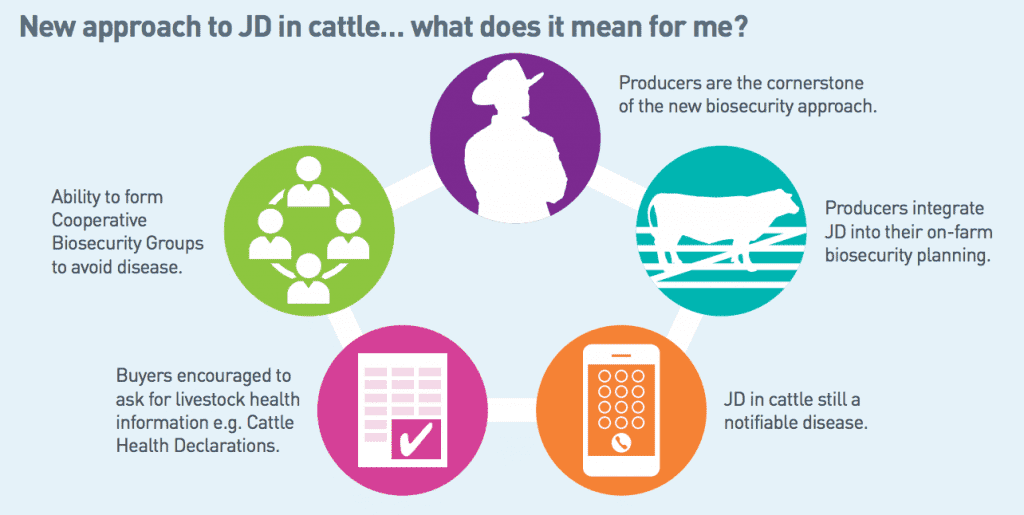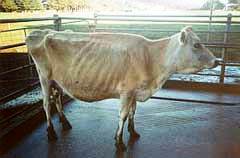
A diagram from Animal Health Australia outlining the new deregulated approach to Johne’s management in Australia. Click on image to view in larger format.
The regulated system for controlling Bovine Johne’s Disease in Australia has been dismantled and replaced with a new deregulated approach which places responsibility for managing the disease on individual producers at property level.
All states bar Western Australia have agreed to adopt the new national framework, which removes the previous zoning system for BJD management. WA is operating under interim border controls until it makes a final decision on whether to adopt the national framework.
Opposition to the previous regulated system gained strength after BJD was detected in a Queensland beef stud herd in 2012. The event led to the forced quarantine of hundreds of cattle properties, causing many producers significant financial hardship with inadequate compensation for their losses.
The event saw many people question whether national Johne’s regulations had become a case of “the cure being worse than the cause”. Producers caught up in eradication-focused quarantine programs suffered significant and in some cases devastating impacts to their operations, much worse than they believe they would have suffered in possible production losses had their herds had BJD anyway.
And, as it turned out, the vast majority didn’t even have BJD. As demonstrated in the 2012 case in Queensland, none of the 200 plus trace forward herds were found to be infected with BJD even though there had been a low level of infection in the index herd for many years.
Difficulties involved in eradicating the disease from the natural environment, the fact that different strains of the same disease can infect cattle but only one was was recognised by national BJD rules, questions about the actual impact on production caused by Johne’s disease, among other issues, contributed to the changing tide of industry opinion around Johne’s management.
It has been a long and challenging road but a changed national approach is now in place.
So how did we get to this point, and what do the changes really mean?
Beef Central asked Alex McDonald, who has represented the Australian Registered Cattle Breeders Association on BJD issues since 2000, to break down for our readers what has happened, what has not happened, and what has yet to happen for Johne’s management in cattle.
Background
Animal Health Australia, which is an independent body funded by industry, manages Johnes disease for multiple species including cattle, sheep, goats and alpaca.
Managing Johne’s disease in livestock involves:
- limiting its spread between areas and properties
- reducing the impact in affected animal groups.
The National Johnes Disease Program coordinates activities in market assurance, disease management, research, diagnostic methods and communication.
Three main components are:
- Market Assurance Program (MAP) for each species which is an audited on farm biosecurity program supervised by an accredited veterinarian;
- Standard Definitions, Rules and Guidelines for each species which set out the rules of how Johne’s Disease is managed in each species;
- Standard Diagnostic procedures for Johne’s Disease.
Management of Bovine Johne’s Disease was managed under the BJD Strategic Plan 2012 – 2020 which replaced a previous strategic plan which ran from 2003 to 2012
The National BJD Strategic Plan aimed to assist the beef and dairy industries to reduce the spread and impact of bovine Johne’s disease (JD) in Australia.
The history of the National BJD Strategic Plan can be viewed on the website https://www.animalhealthaustralia.com.au/what-we-do/endemic-disease/johnes-disease/previous-national-bjd-strategic-plan/
Zones for BJD control
Zoning was introduced in 1999 to contain the spread of BJD:
- Western Australia (WA) was declared a ‘BJD Free Zone’;
- Queensland and the Northern Territory (NT) (traditionally free of JD), as well as most of NSW and northern pastoral areas of South Australia (SA), were declared ‘Protected Zones’;
- Southern South Australia, Victoria and parts of NSW were declared ‘Control Zones’;
- Mainland Tasmania was declared a ‘Residual Zone’, but Flinders Island and the rest of the Furneaux group were declared ‘Protected Zones’.
Higher status zones (i.e. zones with lower risk of JD) protected their favourable status by placing controls on animals moving from lower status zones (i.e. higher risk zones) and by resolving incursions or existing infection as they occurred.
The higher status Zones (WA, Qld, NT) also imposed rigorous requirements for quarantining of infected herds and suspect herds from trace forward and trace back which mainly affected beef herds in NSW, Victoria, and Tasmania. BJD was recognised as endemic in the dairy industries of Victoria and Tasmania so. regulation was difficult in the dairy industry in these states.
Zoning was reviewed and revised for the 2012–2020 Strategic Plan, with NSW and the lower part of South Australia becoming “Beef Protected” Areas (management of BJD in dairy cattle was effectively deregulated in these Beef Protected Areas).
A review of the National BJD Strategic Plan and its associated Standard Definitions, Rules and Guidelines (SDR&Gs) planned for 2015-16 was brought forward and commenced in February 2015.
The main drivers for an early review were:
- The discovery of a herd in central Qld which was infected with JD and the subsequent quarantining of over 200 trace forward herds in Qld, NT, WA and NSW. This herd was infected with the Bison strain of Myobacterium paratuberculosis (Mptb) which was almost certainly introduced with cattle imported from the USA in the late 1980’s.
- The recognition that most of the newly infected beef herds in southern Australia since 2003 were infected with the sheep strain of Mptb acquired when the cattle were co-grazed with sheep infected with Johnes Disease.
- The discovery of a cow infected with sheep strain of Mptb in a herd which had been selling bulls into Qld for the last 15 years.
- Recognition that OJD was now endemic in WA with the likelihood that beef cattle herds in WA had or would be infected with the sheep strain of Mptb.
- Declining resources and the huge cost to State Governments of implementing the regulated approach to BJD imposed by the nationally agreed BJD Strategic Plan and its associated SDR & Gs.
- The severe curtailment of the financial assistance available to herds which had been quarantined due to infection or had been traced forward from infected herds but in many cases were not infected.
- The publication of the report by the Qld Department of Agriculture Fisheries and Forestry which showed that the likely cost to the Qld beef industry of deregulating the management of BJD in Qld was very small compared to the cost of the regulated approach.
The BJD Review Panel established by Cattle Council and Animal Health Australia in early 2015 included the Australian CVO and state Chief Veterinary Officers together with representatives of Cattle Council, Australian Dairy Council, Dairy Australia. MLA, ALFA, ACV, ARCBA https://www.animalhealthaustralia.com.au/what-we-do/endemic-disease/johnes-disease-in-cattle/national-bjd-strategic-plan-review/
The Review Panel produced a report “BJD Where to from here; A fresh approach to the management of BJD in cattle” which was released in February 2016. The new approach to BJD in Australia can be viewed on https://www.animalhealthaustralia.com.au/what-we-do/endemic-disease/johnes-disease/national-johnes-disease-project/new-approach-jd-cattle/
Since then the industry together with Animal Health Australia and State Departments of Agriculture have been “dismantling” the former regulated approach to BJD.
- In some cases such as Qld this has meant changes to state legislation which were introduced on 1 July 2016.
- The former Standard Definitions, Rules and Guidelines for cattle have been revoked which means that BJD Zoning has been removed.
- The National Cattle Health Statement has had the BJD declaration statements changed and a new National Cattle Health Declaration was placed on the Farm Biosecurity website (http://www.farmbiosecurity.com.au/toolkit/declarations-and-statements/) on 3 August 2016.
A number of new “Tools for Managing BJD” were also posted on the AHA website on 3 August, 2016 (https://www.animalhealthaustralia.com.au/jd-cattle-tools/) which include;
- Johne’s Beef Assurance Score (J-BAS) to help producers assess risk of a source herd being infected with BJD;
- Johne’s Disease Biosecurity Checklist to assist producers to further assess risk and to use in the establishment of an on farm BJD Biosecurity Plan;
- JD in Cattle Definitions and Guidelines which mainly covers approved tests and testing procedures such as “check testing” and “sample testing”
- Co-operative Biosecurity Group Guidelines for groups of breeders who wish to establish a regional biosecurity area;
- A description of the cattle JD vaccine “Silirum”.
What has not happened?
Unlike the other states, Western Australia has not adopted the new National Framework for BJD.
Pending a “cost/benefit” analysis WA has retained its current legislation which retains the previous entry requirements for cattle from other states being Market Assurance Program (MAP) status for cattle from NSW, Vic, Tas and SA and a “Check Test” requirement for cattle from Qld and NT.
What has yet to happen
The Market Assurance Program (MAP) is currently under review. The MAP is an audited, on farm BJD Biosecurity Plan which is (still) necessary to allow cattle to be introduced from the south eastern states to WA. It also allowed seedstock herds to provide a high level of BJD risk assurance to their clients and other seedstock herds. This report is expected in the near future and is likely to recommend that MAP be replaced by an on farm biosecurity plan which includes periodic testing and a veterinary advisor but does not require external auditing or state Government supervision and monitoring.
Alex McDonald’s view: Deregulation of Johne’s inevitable and justified
“In short the Strategic Plan was established in 2003 by negotiation between the states and between the beef and dairy industries. It was approved by Cattle Council Australia, Australian Dairy Farmers, and Dairy Australia .
While the BJD Strategic Plan was nationally agreed it was in effect the states which believed they had zero or very low incidence of BJD (WA, NT and Qld) dictating to the other states how they had to manage BJD if their cattle were to be allowed entry into those jurisdictions.
Initially there was no financial assistance available to quarantined herds in the Strategic Plan.
After representations from ARCBA in 2004,Cattle Council of Australia introduced a Financial and non Financial (counsellors) scheme for quarantined beef herds to try to reduce the emotional stress on owners of herds and to explain the financial assistance available to help them get out of quarantine. The financial assistance available to quarantined herds was severely reduced in October 2012..
Management of BJD has been based on an incorrect belief that if a state or jurisdiction could demonstrate freedom or (supposed freedom based on minimal testing) from BJD that the cattle industry in that state would have some sort of advantage with regard to the export of live cattle and beef..
The export of chilled or frozen beef does not depend on the BJD status of the supplying herd because the high level of hygiene in abattoirs minimises the risk of contamination of meat products from gut contents.
The certification of the health status of live cattle for export relies on a property health declaration and the claimed health status of the jurisdiction is irrelevant.
The deregulation of the management of BJD was inevitable despite the last ditch efforts of WA to resist change.”


